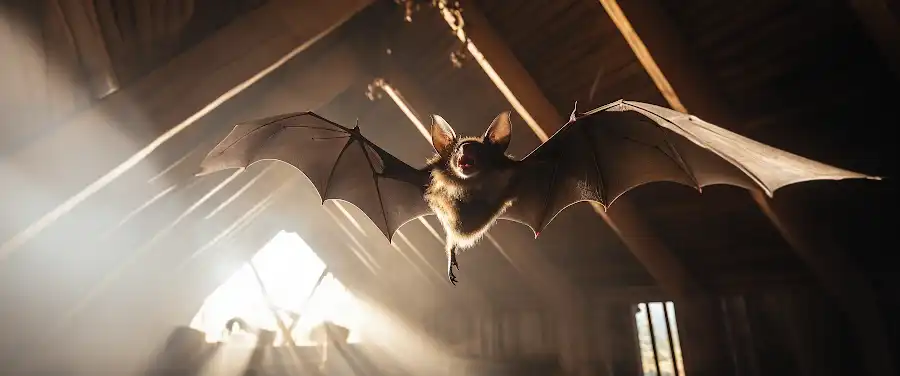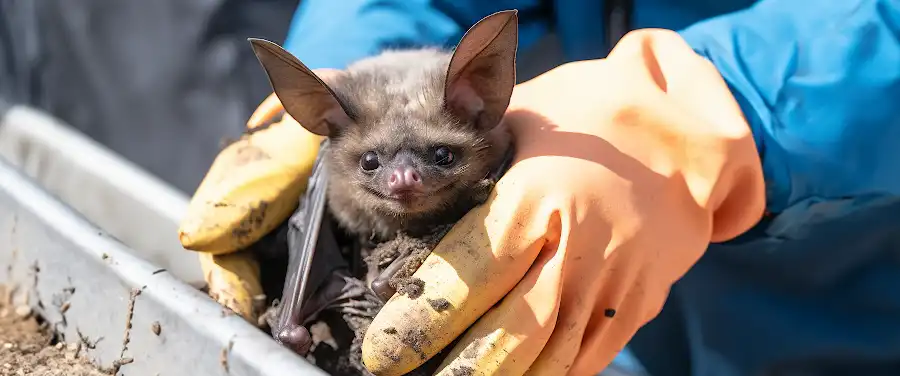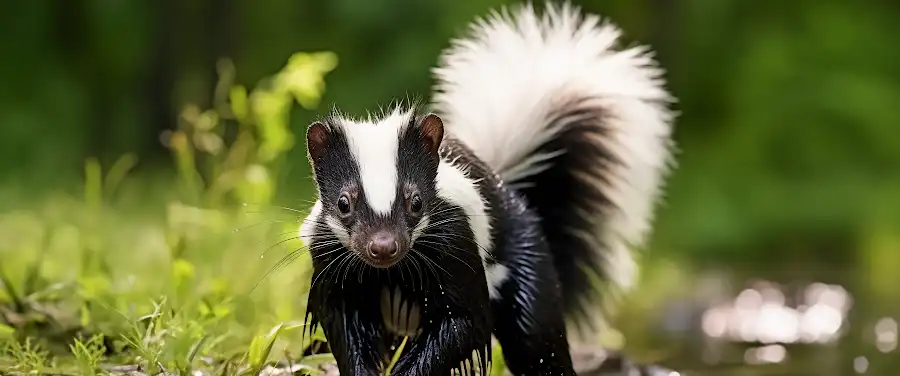
Ever wondered what makes skunks so notoriously off-putting? Ever crossed paths with a black-and-white furball with a disarmingly cute face but equally terrifying tail? If yes, you’ll know we’re talking about skunks, the cute-looking creatures with a reputation that precedes them. As much as they look soft and huggable, their distinctive odorous spray is enough to make anyone think twice about cozying up to them. But what if I told you that the pungent spray that makes your nose turn up is an intrinsic part of the skunk characteristics and their very life?
As if a discussion about skunks and their natural repelling mechanism couldn’t be more exciting, let’s dive deeper into what exactly this formidable skunk spray is. No, it’s not like the air freshener spray you use in your home when expecting guests. Quite the opposite, in fact. And therein lies the mystery, the quirks and the answers – behind the invisible curtain of an odoriferous spray that stuns, startles and stops anyone in their tracks. Understanding the nature of skunk spray, its ingredients, and why it exists at all opens the door to an adventurous journey into the wild, and perhaps, to an empathetic understanding of these misunderstood creatures’ life.
The key to this journey is the chemical makeup that gives skunk spray its infamous reputation. Ever stopped to consider what elements nature combined to create such a potent defense weapon? Ah! Hold that thought and get ready to unravel the secrets. The signature skunk spray is not merely a vile smell; it’s these creatures’ natural defense system, their survival mechanism, the role of spray in skunks’ life. It gets more interesting as we understand this marvel of nature and find out how skunks are simply playing their part in the great circle of life.
Over the next few minutes, you’re going to step into the black and white world of these remarkable creatures. Buckle up and hold your breath as we are about to reveal the fascinating secrets behind the minor miracles of biology tucked away in the tails of these innocuous-looking mammals. Prepare to be amazed as you discover “How Does A Skunk Spray?” and the subsequent marvels of nature’s genius.
How Does a Skunk Spray?
So, you have probably heard about the notorious skunk spray and you’re curious to find more about it, especially from the standpoint of protective behavior, right? Well, imagine this scenario; a cute little skunk wandering around its habitat but suddenly it senses a threat. What does it do? It uses one of nature’s most potent defensive mechanisms – a foul-smelling spray from its anal glands.
Skunks aren’t just paranoid critters spraying at everything that moves. No, their spray is a last-resort defensive strategy designed to ward off a long list of predators, including foxes, wolves, and even bears. The reasons for spraying might vary. A skunk can use its spray when it’s scared, startled, or under attack. Kind of like our fight or flight response, but way smellier!
To better understand this behavior, let’s take a closer look at the threats that trigger the skunk’s spray, when and why it’s used, and what goes on inside its mind (and body) at the moment of the act.
Predators and Threats That Skunks Ward off Using Spray
Contrary to popular belief, skunks wish to avoid confrontation as much as possible. But when a predator looms, such as a voracious fox or an aggressive dog, and the skunk senses an immediate danger, it does not hesitate to use its sulfur-laden spray. The smell is often enough to deter the most determined attackers, but if not, it can cause temporary blindness and create significant discomfort for the predator.
According to statistics from the Humane Society of the United States, dogs are the most common predators to get sprayed due to their enthusiasm often being perceived as aggression. Every year, countless dog owners go through a minor crisis, figuring out how to de-skunk their curious pets!
Range of Emotions and Situations Leading To Spray
Now, let’s highlight specific emotions and situations that might result in a skunk spraying. They don’t just spray willy-nilly; certain triggers must be present. Here are some of the most common ones:
- Fear: Skunks will spray when they feel under threat and see no escape.
- Surprise: Startle a skunk, and it might respond with a spray.
- Aggression: If another animal acts aggressively toward a skunk, it will defend itself with a spray.
Situational Triggers
Emotional Triggers
Now that we’ve unravelled the secrets of skunk spray and their behaviours, it becomes clear that skunks use their pungent weapon as an essential part of their survival strategy. Remember these creatures aren’t out to stink up your day; they’re just trying to keep themselves safe in a world that can be full of threats.
On to our next topic, “ How Effective is Skunk Spray as a Defense Mechanism?” Stay with me to explore the potency of this uniquely defensive trait.
How Effective is Skunk Spray as a Defense Mechanism?
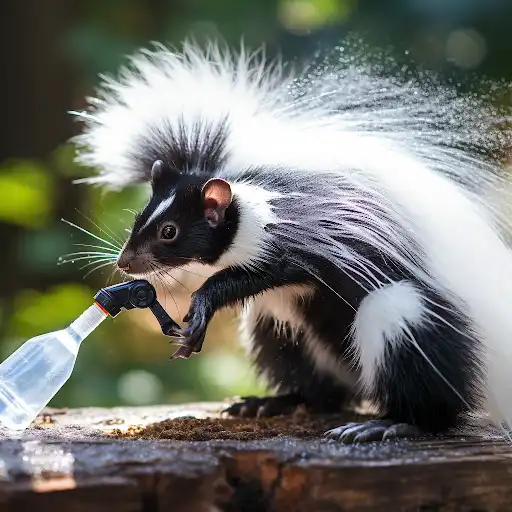
Imagine this: you’re in a dark forest, raindrops are pattering on the leaves above, and suddenly you sense a peculiar odor – a pungent, mass of musk that is as terrifying to wildlife as it is disagreeable to the human nose. The culprit? A skunk, whose spray serves as a potent defense mechanism against potential threats.
In the wild, this spray serves a dual purpose: warning potential predators of the skunk’s presence while simultaneously warding them off, either by temporary blindness or sheer repulsion. This is due to the unique blend of sulfurous chemical compounds known as thiols, which are responsible for the vile scent.
Statistically speaking, the effectiveness of skunk spray as a defense mechanism is remarkable. It’s estimated that the success rate of spray as a defense is around 90% for most skunk species. It’s quite a deterrent – causing would-be predators to think twice before engaging in a skirmish.
But how does the skunk’s defense mechanism stack up against other wildlife? Let’s delve deeper to gain a broader perspective.
| Wildlife | Defense Mechanism | Effectiveness Rate |
|---|---|---|
| Skunk | Spray | 90% |
| Porcupine | Quills | 85% |
| Turtle | Shell | 80% |
| Snake | Poison | 75% |
From the table, it’s apparent that the skunk spray holds its own against other prevalent wildlife defense mechanisms. While all these animals use unique ways to protect themselves, the skunk’s spray is arguably the most multifaceted – it doesn’t just hurt, it stinks!
Of course, much like the majestic cheetah or the hulking gorilla, every animal in the wild has its strategies for survival. However, the skunk’s approach is notable for its distinct complexity. It ingeniously uses a relatively non-violent method that nonetheless deters predators effectively – a masterstroke of evolutionary adaptation.
It’s important to stay contextually relevant and recognize that these behaviors are not just random antics but a fascinating exploration of nature’s survival strategies. They offer intriguing insights into the rich tapestry of wildlife behavior, where every creature has its unique course of action.
With this understanding, we can better appreciate the skunks’ unique methods, their ingenuity, and the pivotal role they play in the ecosystem.
As we journey deeper into the world of wildlife defenses and survival strategies, we transition naturally into our next topic. Buckle up as we explore: ” What Are Some Noteworthy Skunk Behaviors and Habits?” We’ll take a deep dive into some fascinating habits that allow skunks to thrive in the diverse habitats they occupy.
What Are Some Noteworthy Skunk Behaviors and Habits?
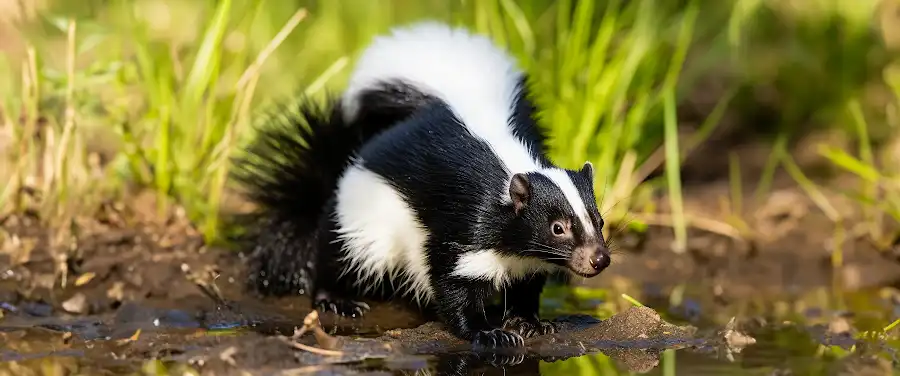
Have you ever wondered about the dynamics of skunk life? What are their feeding habits? How do they interact socially? We often get engrossed in our world and forget other species have fascinating behaviors too. Skunks especially, display intriguing activities and habits worth learning.
Skunks are nocturnal creatures, mostly active during the night when they venture in search of sustenance. They forage on various food sources, exhibiting an omnivorous diet. From harmless insects like beetles and crickets to equally opportunistic snacks like roots and berries, their feeding habits are quite varied. Remarkably, they are ingenious and change their diet according to the season.
In terms of skunk’s social behavior, they are a paradox. Skunks are somewhat solitary creatures, usually only gathering during the mating season. However, during harsh winters, they become more companionable and often share dens for warmth. Interaction amongst skunks only intensifies during the mating season when males go out of their way to charm the females.
Talking about reproduction in skunks, it is another fascinating dynamic. Female skunks bear the offspring once annually, birthing on average 5-6 young ones, known as kits. Unlike many other mammals, the male skunks don’t stick around to assist in raising the kits. Instead, the female cares for the young ones until they mature enough to venture and survive independently.
Now, here is a table summarizing the fascinating life of a skunk
| Skunk Behavior | Description |
|---|---|
| Feeding Habits | Omnivorous diet; varies with seasons |
| Social Interaction | Solitary except during winter and mating season |
| Reproduction | Females give birth once annually with average of 5-6 kits |
What is the Impact of Skunk Spray on Humans and Pets?
When a skunk protects itself using its trademarked defensive spray, the impact can be quite dramatic for both humans and pets. This pungent secretion, known to many as skunk spray, has many effects on those unlucky enough to experience its wrath.
Human Reaction to Skunk Spray
Indeed, humans typically find the scent of skunk spray overwhelmingly unpleasant, reminiscent of rotten eggs or garlic. Aside from being an olfactory nightmare — it’s consistently ranked as one of the smelliest substances in the world — skunk spray can also lead to numerous health issues. It may cause temporary blindness if it gets into the eyes and induce nausea due to its powerful odor.
Effect of Skunk Spray on Pets
Likewise, pets, especially dogs and cats who are often curious about these striped creatures, are not exempt from the impacts of skunk spray. Similar to human reactions, pets may experience temporary blindness and nausea. Additionally, pets sensitive to the spray can manifest skin redness and even develop allergic reactions.
Health Impacts of Being Sprayed by a Skunk
Maintaining a further level of gravity, being sprayed by a skunk can have long-term health impacts. These include persistent skin irritation, potential risk of anemia (as per research conducted by Veterinary Clinics of North America), and occasionally, Rabies, a lethal viral disease transmitted via animal bites and saliva.
Immediate First Aid and Remedies After a Skunk Spray Attack
While encountering a skunk may seem daunting, understanding the first aid steps and remedies after a skunk spray attack could be tremendously helpful. For instance, if the spray gets into the eyes, immediate flushing with water is recommended to alleviate discomfort. Similarly, numerous household remedies, like bathing in a mixture of hydrogen peroxide, baking soda, and liquid soap, can help neutralize the smell from skin and clothing.
In conjunction with these remedies, consulting a healthcare provider for mitigating possible health issues is always a wise move. Especially when pets get sprayed, a quick visit to the vet could save them from further discomfort or possible allergies. To learn more about these remedies and precautions, visit this authoritative resource.
As enlightening as understanding the impact of skunks spray is, it’s still best to prevent such incidents from happening in the first place.
Conclusion
Well, here we are at the end of an incredible journey of understanding skunk spray and behaviors. We’ve learned quite a lot about these intriguing creatures, haven’t we? We’ve come to understand that skunk spray serves as a powerful defense mechanism, a special tool gifted by nature that allows skunks to protect themselves against potential predators. Fascinatingly enough, the pungent odor, while an inconvenience to us, is a vital tool for the skunk’s survival.
Our knowledge navigation also reminds us of just how essential it is to respect wildlife. It’s not merely about keeping our distance to avoid the notorious spray, but also about appreciating the uniqueness of wildlife and the role every creature, including skunks, play in the ecosystem. It’s about realizing the world we share with such diverse species is vast and full of fascinating wildlife behavior.
Take a moment to think about the skunks in your area. Your appreciation of them will be vastly different now, won’t it? With this newfound knowledge, you’ll likely be more curious and aware of your surroundings, observing these creatures from a safe distance and understanding their behaviors with respect and fascination rather than distaste or fear.
Now, as we close the chapter on understanding skunk behavior and enter the world equipped with richer knowledge, remember this – every creature, no matter how small or seemingly insignificant, contributes to our stunningly diverse and delicate ecosystem. After all, aren’t our differences what make us even more incredible?
Do you think the animals in your backyard are just guests, or are they part of your extended family? The manner in which we answer this question reflects how well we have understood and appreciated life in its various forms and dimensions.
So, next time you get a whiff of that unmistakable skunk spray, take a deep breath (note: from a safe distance), smile, and embrace the wonderful world of wildlife!


